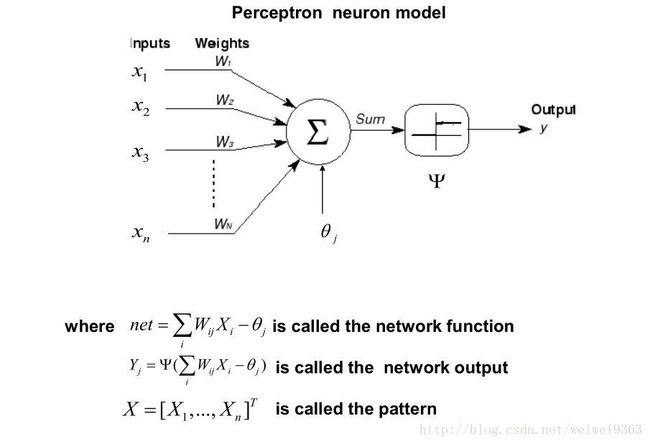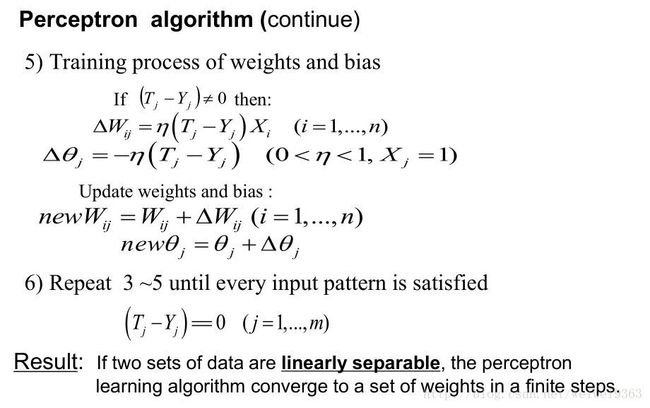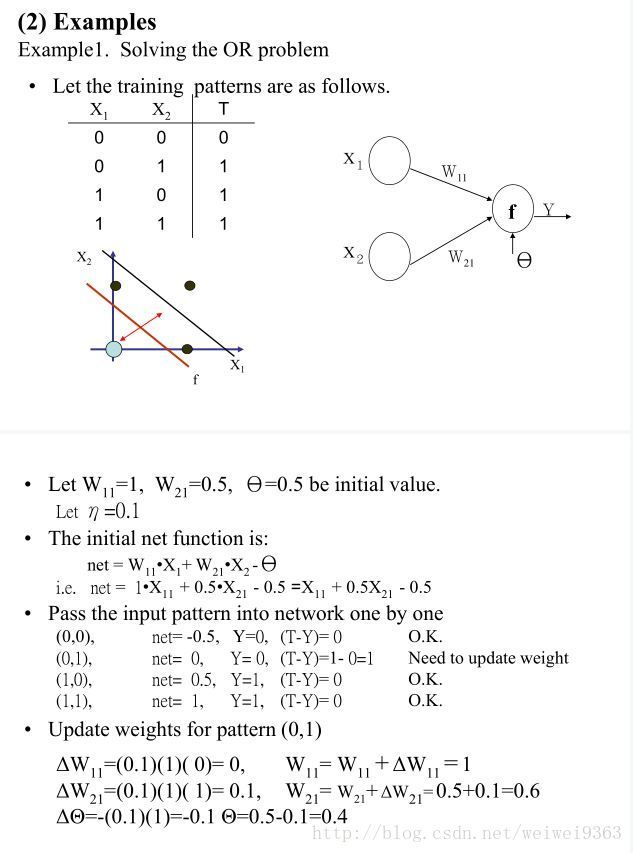神经网络之感知器算法简单介绍和MATLAB简单实现
Perceptron Learning Algorithm
感知机学习算法,在1943年被生物学家MeCulloch和数学家Pitts提出以后,面临一个问题:参数需要依靠人工经验选定,十分麻烦。因此人们希望找到一种能够自己选定参数的方法。1957年,Frank Rosenblatt提出了Perceptron,是一种人工网络模型,并在这个基础上,提出了Perceptron学习算法,用于自动选定参数。




这里思考一个问题:为什么这个更新法则会成功收敛到正确的权值呢?在卡内基梅隆大学编写的《机器学习》中有提及这个问题。大致意思如下
为了得到直观的感觉,考虑一些特例。假定训练样本已经被感知器正确分类。这时, (Tj−Yj) 是0,这使得 ΔWij 为0,所以权值没有修改。而如果当目标输出是 +1 时,感知器输出一个 0 ,这种情况下为使感知器输出一个 +1 而不是 0 ,权值必须被修改以增大 WX 的值。例如,如果 Xi>0 ,那么增大 Wij 会使得感知器更接近正确分类的实例。注意,这种情况下训练法则会增长 Wij ,因为(T_j-Y_j)、 η 和 Xi 都是正。例如,如果 Xi=0.8 , η=0.1 , TJ=1 且 Yj=−1 ,那么权更新就是 ΔWij=η(Tj−Yj)=0.16 。另一方面,如果 Tj=−1 而 Yj=1 ,那么和正的 Xi 关联的权值会减小而不是增大。同理当 Xi<0 时,也有上面的收敛的性质。
事实上可以证明,在有限次地使用感知器训练法则后,上面的训练过程会收敛到一个能正确分类所有训练样例的权向量。前提是训练样例线性可分,并使用了一个充分小的 η (参加Minskey & Papert 19691)
需要注意的是,这个模型只能用于线性可分的数据,对于非线性可分的数据,上述的学习算法将无限循环。
MATLAB 实现
原理很简单,代码实现起来也不难。我们直接上代码
需要说明的是,我们的数据集,包括两个部分:数据和标签。Perceptron.m中的X,大致应该长这样:
举个例子(逻辑运算OR)
最后一列,只有0或者1,表示两类
Perceptron.m
function [ w, t ] = Perceptron( X, f, step, init_w, init_t )
%PRO Summary of this function goes here
% X: data set with label
% f: active function
% step: step size
% init_w:
% init_t:
if nargin < 5
init_t = 0;
end
if nargin < 4
init_w = [];
init_t = 0;
end
if nargin < 3
step = 0.1;
init_w = [];
init_t = 0;
end
label = X(:,end);
data = X(:,1:end-1);
[n_data,n_fea] = size(data);
n_w = size(init_w);
if n_w ~= n_fea
init_w = ones(n_fea,1);
n_w = n_fea;
end
w = init_w;
t = init_t;
while true
result = f(data*w - t);
result = label-result;
index = find(result ~= 0);
n_index = numel(index);
if n_index == 0
break
end
for i=1:n_index
dis = result(index(i));
for j=1:n_w
w(j) = w(j) + step*dis*data(index(i),j);
end
t = t - step*dis;
end
end
enddemo.m 对Perceptron函数进行了简单的测试
clc;
c1 = [1 1];
c2 = [5 7];
n_L1 = 50; % number of item with label 1
n_L2 = 20; % number of item with label 2
A = zeros(n_L1,3);
A(:,3) = 1;
B = zeros(n_L2,3);
B(:,3) = 0;
% create random point
for i=1:n_L1
A(i,1:2) = c1 + rand(1,2);
end
for i=1:n_L2
B(i,1:2) = c2 + rand(1,2);
end
%%
% show points
scatter(A(:,1), A(:,2),[],'r');
hold on
scatter(B(:,1), B(:,2),[],'g');
%%
% do perceptron
X = [A;B];
%X = [0 0 0;0 1 1;1 0 1;1 1 1];
[w, t] = Perceptron(X,@threshhold_func)
%%
% plot the result
A = w(1);
B = w(2);
C = -t;
if B==0
%生成100个-C/A放在向量x中.
x=linspace(-C/A,-C/A,100);
%从-A)-(|A|+|B|+|C|)到|A|+|B|+|C|等距离生成100个值放在向量y中.?
y=linspace(-abs(A)-abs(B)-abs(C),abs(A)+abs(B)+abs(C),100);
else
%x从-A)-(|A|+|B|+|C|)到|A|+|B|+|C|,取步长为0.01.
x=-abs(A)-abs(B)-abs(C):0.01:abs(A)+abs(B)+abs(C);
y=(-A.*x-C)./B;
end
hold on
plot(x,y)
%%
% test
test_A = zeros(n_L1,3);
test_A(:,3) = 1;
test_B = zeros(n_L2,3);
test_B(:,3) = 0;
for i=1:n_L1
test_A(i,1:2) = c1 + rand(1,2);
end
for i=1:n_L2
test_B(i,1:2) = c2 + rand(1,2);
end
test_X = [test_A;test_B];
data = test_X(:,1:2);
label = test_X(:,end);
result = data*w - t;
index = find((label - result)~=0);
n_index = numel(index);
fprintf('正确率:%f\n', (n_index/(n_L1+n_L2)));threshhold_func.m 阈值激活函数
function [ r ] = threshhold_func( x, t )
%UNTITLED Summary of this function goes here
% Detailed explanation goes here
if nargin < 2
t = 0;
end
r = zeros(numel(x),1);
index = find(x > t);
r(index) = 1;
end最后,给出老师课件上的例子,可以自己试试看计算过程是不是一致的。


- Minsky M L, Papert S. Perceptrons : an introduction to computational geometry[M]// Perceptrons: An Introduction to Computational Geometry. The MIT Press, 1969:3356-62. ↩
